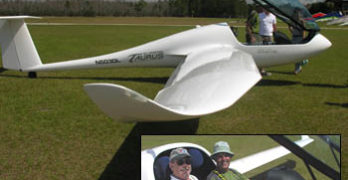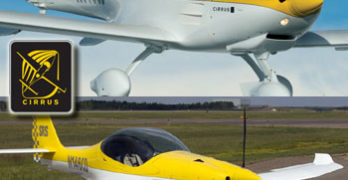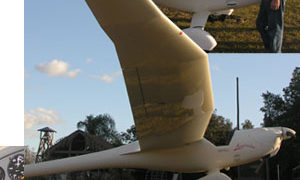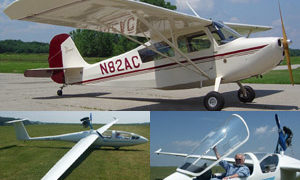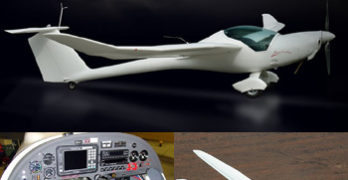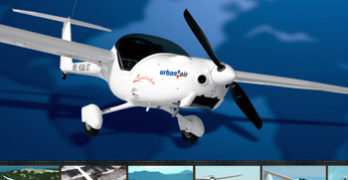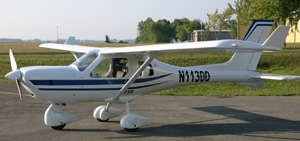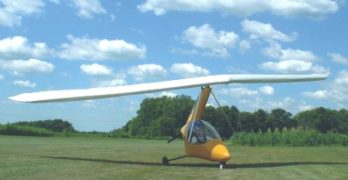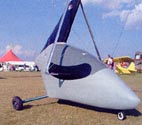Some of you know the Pipistrel line. Americans have seen two of their models: the Sinus and Virus (yep, those awkward, even distasteful names…except representatives prefer to say SEEN-us and VEER-us). Fortunately Taurus is easier on the American tongue, thanks to Ford and its auto model by the same name. *** I discovered Taurus is also easy on the ears as I went for a two-hour soaring flight from Wallaby Ranch with my hang gliding friend, David Ledford. His side-by-side Taurus — roomy for a soaring machine — glides beyond 40:1 and manages a sink rate barely more than 100 fpm. Those numbers translate into plenty of soaring power as we proved on a day with modest convective lift. *** Taurus is a self-launched sailplane, rather than a motorglider like Urban Air’s Lambada or Pipistrel’s own Sinus. To get aloft, we were powered by a Rotax 503 two-stroke engine that fits neatly into a cavity aft of the cockpit.
Search Results for : motorglider
Not finding exactly what you expected? Try our advanced search option.
Select a manufacturer to go straight to all our content about that manufacturer.
Select an aircraft model to go straight to all our content about that model.
Cirrus SRS Orders + a dozen LSA & an Ultralight
SEBRING 2008 — Opening day started fast with press announcements from Cirrus — the GA company started taking orders for their SRS — and from Flight Design as the company unveiled their much-anticipated CTLS. But that was hardly all as the fourth Sebring Expo got going. I found a dozen newsworthy airplanes at the event and I may have missed some (I’ll keep searching). *** Gobosh introduced the 800XP, a sleek composite companion to the metal 700S. Sport Aircraft Works offered their just approved Dynamic LSA with fixed gear and prop. Skykits showed their shiny new Rampage with electric slots and Fowler flaps, and Urban Air USA showed their Lamabada LSA motorglider for the first time at a U.S. airshow. SportairUSA revealed their third generation Sting S3 with a new wing design and other updates.
Long-Gliding Lambada Soars Into Sebring 2008
SEBRING 2008 UPDATE — After watching hang gliders speck-out to 5,000 feet at Wallaby Ranch, I was caught off guard when a slippery white airplane streaked across my field of vision. Following a low pass, the bird with the gorgeous slender wings turned and approached for landing. At a hang gliding resort like Wallaby, the 30:1 Lambada quickly drew a crowd of admirers. Urban Air USA proprietor Josef Bostik flew in to show off the newly certified SLSA motorglider. *** PHOTOS: The multiple-compound wing is about as far from a rectangular Hershey Bar wing as a designer can go. At lower left, the circled red handle changes a spring-loaded prop to full feather for lower drag during soaring flight (it is not technically an adjustable pitch prop). At lower right, you see the prop at full feather. Not seen are wing spoilers that deploy with a handle between the seats similar to a flap lever.
Two New Categories Gain Approved LSA
Among new LSA approvals, some sneak by my observation post. Two new entrants make an interesting couple. One is our first-ever glider approval; the other is a new “Sport Pilot eligible” aircraft but not an SLSA. Curious? *** LSA Gliders of Wisconsin won a SLSA airworthiness certificate for the first glider meeting ASTM standards. They import the TST-14 Bonus, a lovely long-winged, self-launch motorglider of interest to soaring enthusiasts. The all-composite tandem two-seater can be a pure glider or take a boost from a Rotax 503; either way it claims a 40:1 glide angle. “It can be registered as a SLSA Glider or an experimental,” says importer Steve Meassick. *** Taking another tack is American Champion (ACA), whose 7EC is not a SLSA but a Standard Category production aimed at use by Sport Pilots or licensed pilots exercising those privileges (no medical needed). The maker of the Citabria (in which I logged my first 35 hours) to Super Decathlon now offers “The Champ” for $85,900 in basic form without flaps.
Urban Air USA Brings Lambada Closer
Bostik Industries is known to some LSA buyers as “the other supplier” of emergency ballistic parachute systems (Magnum). Indeed, that activity appears to be thriving as major producer BRS Parachutes intensifies its focus on larger GA airplanes and light jet projects. *** An affable Joe Bostik (airline captain and champion hang glider pilot) is also the U.S. agent for the shapely Lambada motorglider. Though soaring pilots will be instantly drawn to this reasonably priced motorglider (less than $100,000; other choices can cost much more), the airplane also works as a cross country cruiser, able to fly 800 nautical miles at speeds of 100 mph. Though Rotax 9-series engines offer great reliability, should the powerplant go quiet, a Lambada pilot can glide up to six miles from only 1,000 feet off the ground. Bostik now has his Lamabada website well populated with info, specs, and photos.
Long-Wing Cross Country Cruiser & Soaring Machine
One actually got approved last year, I’m told, but a new 2008 model Urban Air Lambada UFM 13 more recently received its airworthiness as our newest, and 57th, Special Light-Sport Aircraft (SLSA). This is the second aircraft to use the ASTM standards for Glider (see 8/6/07 SPLOG) but is the first motorglider. TST-14 is more properly a “powered sailplane,” a rather fine but clear distinction. Imported by Bostik Industries LLC, Lambada is part airplane and part sailplane. It glides an impressive 26:1 or 30:1 from a 42.65- or 49-foot wing setup (both are standard; you exchange wing tips). Yet using the 80-hp Rotax 912 it will also cruise at better than 100 mph for 800 nautical miles on 26.4 gallons of fuel in two wing tanks. Lambada is a carbon and glass fiber shoulder-wing design available in taildragger or tricycle gear. It also comes standard with a Magnum Ballistic Parachute system, folding prop, stainless steel exhaust, and tinted canopy for $93,500.
Triple Play by Jabiru USA; Calypso SP Certified
Pete and Ben Krotje and their team have done it again. They won an Special Light-Sport Aircraft airworthiness certificate for Calypso SP, their third and SLSA number 40 in the USA. Last November the Shelbyville, Tennessee company certified the roomy J-250 and flight school-oriented J-170. Pete said, “Calypso Sport is a Special-Light Sport certificated version of Jabiru’s proven UL with wheel pants, six-inch wheels, winglets, and other upgrades.” Calypso SP’s lower ventral fin has been reduced in size and the flaps have been extended by 72 inches. This resulted in a LSA that stalls at 35 knots, demonstrates a very short takeoff, and has near-motorglider performance at a reported 18:1 with the engine at idle. Jabiru USA says Calypso SP can cruise at 100 knots on less than four gallons an hour but when operated around 70 knots sips a mere two gallons per hour. The SLSA airworthiness was awarded on September 8th.
Seagull Aerosports takes a new angle
Seagull Aerosports takes a new angle on weight-shift construction with a fully enclosed cockpit.
Developer Michael Riggs might prefer I called his Escape Pod something other than Everyman’s Motorglider, but if you have any interest in self-launched soaring flight, Riggs’ invention is one of the most cost-efficient purchases you can make. The Escape Pod costs thousands less than ultralight motorgliders and literally hundreds of thousands less than sailplane motorgliders.
Oh, and one more thing this kind of flying machine is a hoot to fly. That the Escape Pod also transports easily, can be stored in a small space and is attractively shaped are icing on the cake.
Sure, it’s obvious-I like the Escape Pod. But could it be for you, too? Even if this aircraft isn’t your type, you might enjoy reading about how thoughtfully it was designed.
Trike Motorgliders
Before the Sport Pilot/Light-Sport Aircraft (LSA) rule was recently passed, trike enthusiasts had several other ways to fly such aircraft.
Part 103 Ultralight Trikes
Part 103 ultralight trikes aim at soaring pilots.
Many visitors to Oshkosh AirVenture 2003 expected the FAA to announce its new sport pilot/light-sport aircraft rule. New Administrator Marion Blakey reported signing off on the rule on July 30, but with two other agencies in line to review it, we aren’t likely to see the final version until 2004.
Visitors may not have expected to see more than a few Part 103 ultralight aircraft at AirVenture (some thought they would disappear as LSA approaches). But there were many. Next month I’ll write about two Part 103 rotary-wing aircraft, but this time, the subject is nanotrikes.
Nanotrike is a term to describe extremely light wheeled structures combining powered paraglider engines and contemporary hang glider wings. The idea is to create a low-cost, self-launching ultralight motorglider.
Trike Pod
Minnesota-based Seagull Aerosports debuted its Escape Pod at Oshkosh. Pushed by a single-cylinder Cors-Air engine generating 25 hp, the Escape Pod weighs only 75 pounds.
Product Lines – November 2004
ST. PAUL, MINN. — Just as the October “Product Lines” was headed to press a last-minute
update was inserted into the column by USHGA’s alert art director, Tim Meehan. At
the end of last month’s column I was writing about Alan Chuculate’s paraglider
aerotow trike, the SlowTow. A week after the deadline, Alan wrote, “The SlowTow
project suffered a major setback on Wednesday when Floyd Fronius crashed
in the trike and crushed a vertebrae and his heel. It was a classic case of a low
altitude aerotow problem resulting in the towplane pilot getting pitched down and
not releasing early enough. Both trike and glider were airborne at approximately
150 feet AGL.” Alan reports that Floyd thought the glider had released because the
towline was slack. He began to descend and turned left to reconnect and try again.
“But as he turned left the towline tightened rapidly, the glider climbed dramatically,
and the trike was slowed and pitched nose down.” Perhaps Floyd should have released
at the first sign of the problem, but it takes a short time to comprehend the situation
and he didn’t have those precious seconds.
- « Previous Page
- 1
- …
- 18
- 19
- 20
- 21
- 22
- 23
- Next Page »


